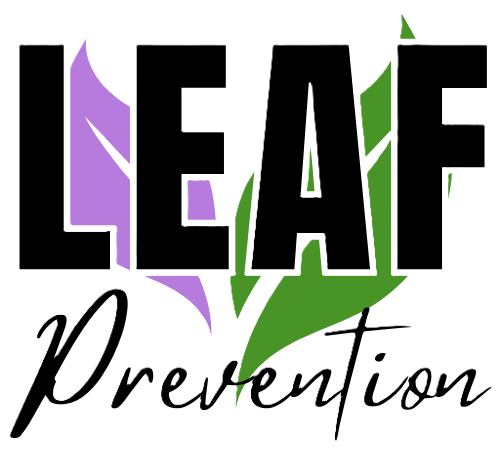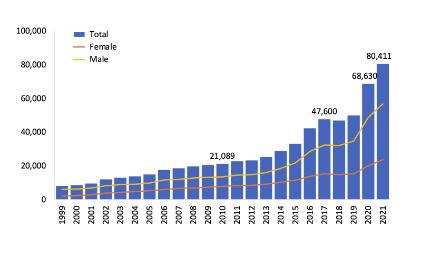

Blog Posts
Did you know that opioid overdose now claims more lives than motor vehicle crashes in the United States? It's a terrifying trend that only worsened during the coronavirus pandemic. LEAF is part of a local partnership responding to the crisis, supporting everyone in the community to respond to opioid overdoses with life-saving action.
What Is the Opioid Crisis?
Opioid overdose has become one of the leading causes of preventable deaths, steadily growing over the past thirty years. Some of the stats are hard to wrap your head around:
Figure 1. National Overdose Deaths Involving Any Opioid, Number Among All Ages, by Gender, 1999–2021

Substance Abuse and Mental Health Services Administration "Opioids" www.samhsa.gov/data/taxonomy/term/442. First three bullet points all from Centers for Disease Control and Prevention "The Drug Overdose Epidemic: Behind the Numbers" www.cdc.gov/opioids/data/index.html . National Institutes of Health "Kahoot quiz" create.kahoot.it/details/58ddf21e-c0a6-4a6d-bf9c-d8405303945e. NYS Office of Addiction Services and Support "NYS Overdose Death Dashboard" oasas.ny.gov/overdose-death-dashboard. In 2021—the latest official figures—there were 14 Opioid-related overdose deaths in Chenango and 13 in Otsego. Drug overdose deaths involving any opioid―prescription opioids (including natural and semi-synthetic opioids and methadone), other synthetic opioids other than methadone (primarily fentanyl), and heroin. Source: Centers for Disease Control and Prevention, National Center for Health Statistics. Multiple Cause of Death 1999-2021 on CDC WONDER Online Database, released 1/2023. https://nida.nih.gov/research-topics/trends-statistics/overdose-death-rates
What Can We Do About the Opioid Crisis?
Feeling overwhelmed by the scale of the crisis? We get it. However, underneath those statistics are real people experiencing overdoses. Just as we can learn how to do chest compressions for someone unconscious, we can learn to recognize and respond to an overdose.
What Are the Signs of an Opioid Overdose?
Take a minute to familiarize yourself with the symptoms of an opioid overdose. Key signs include loss of consciousness, minimal or no response, breathing difficulties, unusually slow breathing, vomiting, gurgling or choking sounds, abnormal skin tone or fingernail color, and difficulty speaking. Knowing these symptoms means you're ready to respond promptly and effectively during an opioid-related emergency.
What Do I Do in an Opioid-Related Emergency?
Enter Naloxone, one of the proven tools to respond to an overdose. Also known as Narcan, it's a rapid-acting medication designed to reverse the effects of an opioid overdose within minutes. We encourage people to carry naloxone, just like we might carry a bandaid or an aspirin. And if you’re in a local business and witness a potential overdose, check for a ONEbox™ kit – four doses of Naloxone in a nasal spray with crystal-clear instructions. Remember, though, while Naloxone can bring someone back from an overdose, it's not a permanent fix. Immediate transportation to an emergency room is crucial for additional care once the effect wears off, so call 911 in addition to your own response.
Together We Can Save Lives
Here at the LEAF Council on Alcoholism and Addictions, we're on a mission to prevent opioid addiction and overdose death. All of us can carry Naloxone. And, if we’re an owner or manager in a business, we can keep ONEbox™ kits on-premises and be part of the emergency response to the Opioid Crisis.
To learn more about Naloxone, how to get it, and how to use it, give us a call at (607) 432-0090. #CommunitySupport #OpioidAwareness #OpioidCrisis #SaveALife
